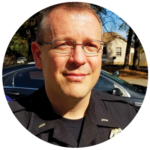InTucker Magazine
March 2019
On the Beat with Lt. Schoeppner – March 2019
Lt. D.G. Schoeppner is Tucker’s liaison to the DeKalb County Police Department and can be followed at facebook.com/dgschoeppner or emailed at dgschoeppner@dekalbcountyga.gov.

Recently I read a comment on the Tucker Precinct Facebook page questioning our response time. It’s not uncommon to get questions about response time at community meetings or citizens calling directly to the precinct. The answer to this question can be complicated. However, there are usually some standard reasons that explain the majority of our response time complaints.
The first thing that influences how long it takes us to respond is the type of call. We are only going to run blue lights and siren to calls that are serious felonies (murder, rape, robbery), life threatening situations, or lesser felonies that are in progress (if your house is being burglarized and the suspects are still inside). We refer to these as priority one calls. In 2017, Tucker Precinct officers responded to 1,208 of these emergency calls. The average response time was 6:38. That is a full three minutes faster than the average response time of the Atlanta Police. It’s also worth mentioning that last year APD had the fifth-best response time of major U.S. cities. Even when you look at lower priority calls, Tucker Precinct has an average response time of 10:42. Tucker officers responded to 50,062 of these calls in 2017. I know this is little comfort to people who had to wait a long time for response, but these instances are relatively few for our average to be that low.
The next biggest contributing factor to response time is the time of day in which you call. There are two separate aspects to this. First is that between 2:00 and 7:00 p.m., we receive the highest volume of 911 calls. During this time of day, it is not uncommon for the number of 911 calls coming in to exceed the number of officers we have working. The result is calls going into a queue and then prioritized by supervisors. This means that even though you may have called in your vehicle break-in or traffic accident first, we are going to respond to the shooting, stabbing or domestic violence call ahead of yours. The other aspect is vehicle traffic volume on the roads. It just so happens that the hours when we receive the most 911 calls is also the time of day when vehicle traffic is the highest. Blue lights and sirens can help when they are appropriate, but for every other call the police officer has to drive through the same traffic as everyone else to get from call to call.
There are other factors, as well. Manpower, the weather or human error can all have an impact on response time. These are not insignificant, but getting too deep into them would exceed the space I have for this article. Our Community Engagement Meeting on March 27 at 6 p.m. at the Tucker-Reid H. Cofer Library would be an excellent place to have a more in-depth discussion. We also have monthly Coffee with a Cop meetings around the area. Look at the Tucker Precinct Facebook page for info on the date and location. I hope to see you there.

